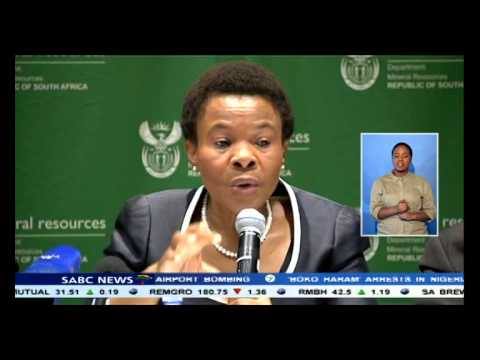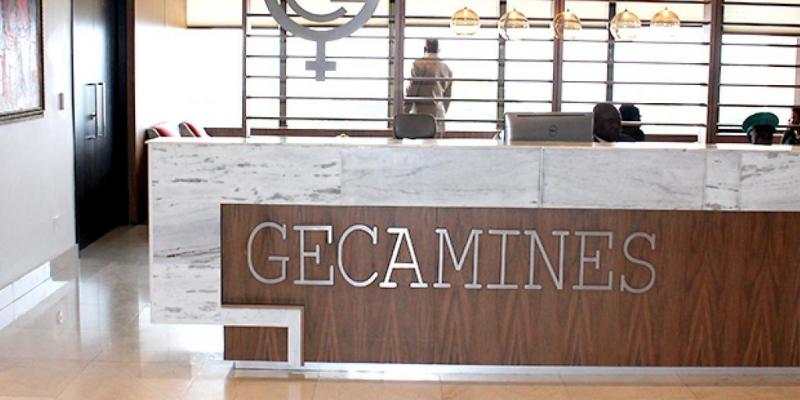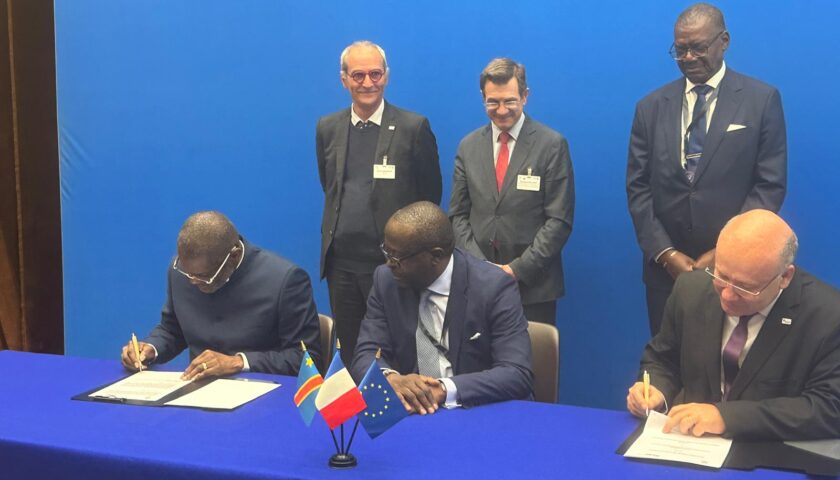Ms Suzane Shabangu, MP, Minister of Mineral Resources of South Africa
Programme Director,
Senior Vice President of the Mining Indaba, Jonathan Moore,
Ministers and Deputy Ministers,
Members of the Diplomatic Corps,
Distinguished Guests,
Ladies and gentlemen,
It gives me great pleasure to officially open and welcome you to the 19th anniversary of the Mining Indaba. The Mining Indaba has contributed significantly in attracting the appropriate attention to the potential of African mining investment and development.
This session is taking place as democratic South Africa is celebrating two decades of freedom.
Since 1994, we have established a society based on non-racial democratic values, the rule of law, the supremacy of the Constitution, social justice and respect for fundamental human rights, including the commitment to address the adverse socio-economic conditions brought about by past discrimination.
These sentiments were expressed by the global icon, Nelson Mandela, who stated in his inauguration address that:
“Our single most important challenge is therefore to help establish a social order in which the freedom of the individual will truly mean the freedom of the individual. We must construct that people-centred society of freedom in such a manner that it guarantees the political liberties and the human rights of all our citizens.” May his soul rest in peace.
We owe Madiba and his generation of liberators – we dare not let them down. We dare not let our own people down, and also those abroad who believed in us and stood with us through the dim days of apartheid.
People ask questions about our future. That is their right, even if we feel confident and secure about the answers.
We do so because of our track record in the stewardship of our economy, including, among others, access to global technology and capital markets unfolding so rapidly before our eyes.
As government, working together with our stakeholders and investors, we are resolute in our determination to build the country of our dreams that inspires confidence for continued development. This is corroborated by the global competitiveness reports that reflect South Africa’s considerable progress in this regard. For instance, the latest World Economic Forum report indicates that out of one hundred and forty eight (148) countries evaluated, South Africa ranks first in the strength of auditing and reporting standards; efficacy of corporate boards; protection of minority shareholder’s interest; legal rights index and regulation of securities exchange.
The report also places us second on availability of financial services and financing through local equity market; third on soundness of banks; tenth on strength of investor protection; sixteenth on effect of taxation on incentive to invest; and twentieth on property rights.
Meanwhile, the open budget index undertaken by the Washington based international budget partnership also rates the country second on transparency and accountability of its budgeting process.
Despite these strides, we are not complacent about the various areas that still require more effort and improvement. However, these indices must provide confidence to the investment community that indeed, not only does South Africa provide an attractive mining destination, but it also provides a globally competitive environment that protects investments.
We have come a long way in the evolution of the post apartheid mining regulatory reform, which started when the ruling party first developed the “Ready to Govern” document in 1992, and culminated in the country’s White Paper on minerals and mining policy.
The Minerals and Petroleum Resources Development Act is a product of tripartism that has come to characterise the culture of this industry. The post-apartheid regulatory framework has unleashed the potent potential for the mining industry of the future, transformed ownership patterns, diversified mining, created employment as well as ended the century old male domination of the industry. Furthermore, the number of mines in operation has increased exponentially, as well as the corresponding revenue generated, while women mineworkers grew from an insignificant number to ten percent currently.
Building on the continuum and jurisprudence of the democratic government, the current administration developed and implemented the “Strategy for sustainable growth and meaningful transformation of South Africa’s mining industry”. The main objective of the strategy sought to place the country’s industry along a trajectory of sustainable growth.
This strategy identified, amongst others, limited infrastructure as one of the binding constraints. Accordingly, the Presidential Infrastructure Coordinating Commission (PICC), chaired President Zuma, has been established and committed over R820 billion in investments. Mining infrastructure requirements feature prominently in the PICC in order to further unlock the known mineral development potential, such as the Waterberg coal resources as well manganese and iron ore in the Northern Cape. This bears testimony to government’s commitment to supporting further growth and development of the industry.
This year is the tenth year of continuous implementation of major regulatory reforms introduced through the Mineral and Petroleum Resources Development Act (MPRDA). The introduction of the MPRDA as mining law in 2004 took all of us into unchartered territories.
The MPRDA vested custodianship of mineral resources with the State, created an enabling environment for growth and the basis for transformation of the industry, promoted orderly development of the nation’s mineral resources, provided for equitable access to the nation’s mineral and petroleum resources and introduced the global trailblazer notion of “social license to operate” through Social and Labour Plans as well as the Mining Charter.
However, the decade-long implementation window has provided us with the benefit of hindsight.
In this regard, the MPRDA Bill, which has been a subject of public debate over the last year, is currently being finalised through our parliamentary processes, and we are confident that it will be concluded during the tenure of the current legislators. The MPRDA Bill will NOT create an uncertain regulatory regime, but on the contrary, the Bill seeks to, inter alia:
Optimise mining, minerals and upstream petroleum development in South Africa;
Strengthen its content, in order to further enhance and continue creating a conducive environment for investment, growth and job creation;
Improve the ease of doing business in the industry, by amongst others, streamlining and integrating mining, environmental and water authorisation processes. This process commits Government to a turnaround time of up to 300 days for a mining right;
Balance business needs with national development imperatives;
Enable synergies amongst mining right holders operating within a District Municipality to optimise community development;
Address loopholes identified in various court judgments, such as outlining detailed consultation processes;
Further entrench and augment the principle of security of tenure as an integral part of South Africa’s mining regulatory framework; and
Promote the mineral value addition of South Africa’s minerals.
With regard to mineral value addition – the provision enables the game changing, win-win value proposition for local processing of minerals. Continued exportation of unprocessed minerals denies South Africa the possibility for skilled employment, skills development and contribution to the fiscus needed to address our developmental imperatives. Let me reiterate my previous messages on our intentions – no mining company is either required to beneficiate or is forced to subsidise the manufacturing industry.
The MPRDA also provides modalities for State participation in the development of the upstream petroleum industry.
We have consulted extensively on the Bill, and we are confident that it provides a predictable, stable and globally competitive mining legislation that promotes investment, inclusive growth, development and transformation.
The year 2014 also marks the ten years of implementation of the Mining Charter, which is also a subject of review. I must commend the bulk of mining companies who have voluntarily supported the evaluation of progress on the implementation of the Mining Charter, which is being carried out by the Department. I encourage all stakeholders to cooperate with the Department to ensure that this process of national importance is successfully finalised. The findings of the evaluation will assist in the review process of the Mining Charter.
Let me emphasise that transformation of the economy generally and the mining industry specifically should not be misconstrued as an event, but a journey and that transformation remains at the centre of development in South Africa.
I have established that some of the companies have designed interim transformation solutions that end this year, with the expectation that 2014 would mark the end of transformation. Nothing could be further from the truth – in fact, transformation remains an imperative of government and must be seen as business imperative in the South African context.
Transformation is a societal imperative to redress centuries of deliberate exclusion of the black majority from the mainstream economy. There can be no sustainable mining and growth of this industry without going to the very heart of transformation. As a result we have agreed with industry to progressively increase resource allocation for skills development to reach and sustain 5 percent of payroll. Skills development includes artisan training and support for increasing the pool of engineers.
Ladies and gentlemen,
Government is excited about major game-changing discoveries of untapped potential for petroleum development, spanning both off-shore and on-shore, including shale gas.
In respect of shale gas, the geology indicates a potential for four hundred and eighty five trillion cubic feet (TCF) resource of shale gas trapped in the Karoo formations. We have published the Technical Regulations for the development of shale gas for public comments and the final Regulations will be released shortly.
We will move ahead decisively, yet responsibly, with the exploration of shale gas, and to unleash its potential contribution to, amongst others, cost-competitive energy security, employment creation and a range of other latent benefits to the country.
We are also nurturing the development of our nascent offshore oil and gas prospects. We welcome a number of multinationals that have expressed interest in the development of this resource. We cannot emphasise enough the need for South Africans to have a fair share from the development of their natural resources.
Programme director
The health and safety of mineworkers is a hallmark of human dignity. In this regard, there has been significant improvement in the health and safety of mineworkers, since former President Mandela established the Leon Commission of Inquiry. This substantial improvement is part of our commitment towards achieving zero harm.
I will soon be releasing the details of the health and safety performance of the mining industry.
Meanwhile, the Mine Health and Safety Act is being amended to strengthen provisions that further encourage best practice relating to the impact that mining activities have on the health and safety of mineworkers and affected communities. We published the Bill last year and subsequently received substantive inputs from our stakeholders. We are confident that the Bill will be presented to the next parliament for processing.
When we look at the current headlines, they tend to focus exclusively on such issues as labour instability. Government has intervened boldly and decisively to provide leadership and restore stability in the sector. All stakeholders committed to a Peace and Stability Framework and subsequently, the Deputy President-led process secured participation of stakeholders through the Framework Agreement for a Sustainable Mining Industry. Initiatives such as the establishment of Mine Crime Combating Forums are already operational.
I would like to implore all stakeholders to continue to work together to ensure that peace and stability prevails. I can confidently declare that we have restored the rule of law, peace and stability in this industry. These developments debunk the myth that labour laws in South Africa lack flexibility and are only created to protect workers. Conversely, our Constitution provides the right of workers to strike, within the prescripts of the law, while simultaneously providing employers with the legal recourse to balance either extreme. The gold industry recently demonstrated that there are sufficient checks and balances for both workers and recourse for employers. All of us must take responsibility in ensuring that the rule of law reigns supreme in the country and the industry. We must commend our stakeholders, especially organised labour, for heeding the call to operate within parameters of the law.
This is the point made so strongly by the Afrikaner, the African and the South African writer, JP Landman, who in his book The Long View makes the compelling point that we, as miners and investors, need “…to take a long (term) view….(to) get a stronger grip on reality…and be assured by the long-term trend-lines rather than panicked by ‘drama’ of today’s headlines.”
He says that for growth to be achieved in a mixed economy like ours requires “…items like confidence, trust, commitment and a sense of a (shared) future.”
Notwithstanding some challenges that we have experienced in the recent past, I am confident that the democratic government has created an environment conducive for inclusive growth and enduring partnerships. To this effect, the substantial investments in the development of the mining industry since confirm this assertion. For example:
The current investment of two billion rands (R2 Billion) by Kalagadi Manganese and the African Development Bank to complete the funding requirements of Kalagadi’s integrated mining and beneficiation project at Hotazel in Northern Cape;
The sizeable inbound listing of Glencore-Xstrata in the Johannesburg Stock Exchange last year marks a renewed basis for more long term and sustainable listing in one of the safest havens;
De Beers’ R20 billion underground expansion of Venetia affirms investor confidence in South Africa;
Imminent development of the Waterberg JV project by Platinum Group Metals Limited.
I am confident that more investors and analysts present here, will evaluate the investment prospects of South Africa appropriately and not be influenced by the immediacy of “headlines”.
We have made great strides since 1994 to transform both the mining industry and the South African economy, We have a far larger, more open, diversified and competitive mining industry. It is in our interest that benefit-sharing be extended to all South Africans. This must be done in an environment of co-operation between large, medium and emerging mining companies.
We must work together to weather the storm of current short term domestic and international circumstances to take our country and the African continent forward.
The African Continent has begun the journey of the African Century, which is focussed on accelerating socio-economic development, to eradicate poverty, inequality and ultimately enhance the living standards of the African people. In this regard, African Union Heads of States adopted the African Mining Vision as a framework for integrated development of mining in the Continent.
Africa’s time, indeed, has arrived. We shall seize our future with both hands, and not fail.
Finally, for our international guests, enjoy your stay in South Africa – we have a lot on offer and are certain that you will discover this during your pleasant stay in the country.
I thank you, and declare the 2014 Mining Indaba officially open.
(Picture by facebook.com)




